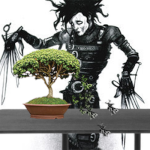Guy wire tourniquet material to use?
+3
marcus watts
Bob Pressler
Poink88
7 posters
Page 1 of 1
 Guy wire tourniquet material to use?
Guy wire tourniquet material to use?
I have been bending branches via wiring, guy wire, jacks, & turn buckles and wanted to do guy wire tourniquet but not sure what wire material to use. What is the preferred material to use? Can I use rebar tie wires (black steel I believe), or aluminum fencing wires (much stronger than what we use for wiring)? Both are available at Lowe's or Home Depot cheaply.
Thanks!
Thanks!

Poink88- Member
 Re: Guy wire tourniquet material to use?
Re: Guy wire tourniquet material to use?
Any will work as long as you're careful and cushion the branch and trunk- I use drip irrigation or aquarium tubing for that. Rebar wire will break easiky with just a little too much twist. I generally use copper- you don't usually need much and its strong and puts up with twisting it tight.

Bob Pressler- Member
 Re: Guy wire tourniquet material to use?
Re: Guy wire tourniquet material to use?
Thanks Bob! 
I am surprised about the rebar tie wire...we usually twist those at the (construction) job site pretty heavily w/o breaking.
I mostly use aquarium air tubing but usually add other stuff on heavier bends. I'll probably start using recycled leather from old shoes soon
I am surprised about the rebar tie wire...we usually twist those at the (construction) job site pretty heavily w/o breaking.
I mostly use aquarium air tubing but usually add other stuff on heavier bends. I'll probably start using recycled leather from old shoes soon

Poink88- Member
 Re: Guy wire tourniquet material to use?
Re: Guy wire tourniquet material to use?
Hi Dario,
so your work remains perfect the wire must not stretch under high or long term tension. I never use aluminium as it stretches easily- (fencing type stretches too so the taught look is easily achieved). Copper wire has very little stretch so i use this for 90% of my guy wiring - (just started humming YMCA - must be the guy wiring ) Stainless steel is commonly used for really big high tension jobs.
) Stainless steel is commonly used for really big high tension jobs.
These days I set up the torniquet tensioner with padded 3mm copper each end, wind the branch into place then straight away put a copper wire loop along side. I pull this tight with pliers and remove the tensioner completely - then twist the loop in the middle to neaten the work and to fine tune the
branch position. Last week I cranked a big branch upwards using 2 torniquet tensioners, then put a strong bamboo rod under it, braced on the pot edge and the branch - this is neat too as there is no wire holding the branch in place.
working like this you only need a few actual tools as they dont stay sat on the tree
have fun,
Marcus
so your work remains perfect the wire must not stretch under high or long term tension. I never use aluminium as it stretches easily- (fencing type stretches too so the taught look is easily achieved). Copper wire has very little stretch so i use this for 90% of my guy wiring - (just started humming YMCA - must be the guy wiring
These days I set up the torniquet tensioner with padded 3mm copper each end, wind the branch into place then straight away put a copper wire loop along side. I pull this tight with pliers and remove the tensioner completely - then twist the loop in the middle to neaten the work and to fine tune the
branch position. Last week I cranked a big branch upwards using 2 torniquet tensioners, then put a strong bamboo rod under it, braced on the pot edge and the branch - this is neat too as there is no wire holding the branch in place.
working like this you only need a few actual tools as they dont stay sat on the tree
have fun,
Marcus

marcus watts- Member
 Re: Guy wire tourniquet material to use?
Re: Guy wire tourniquet material to use?
I use this nice annealed steel fencing wire that they sell on small bolts at Lowes. As it has been annealed, it has the strength of steel with the easy to work with bendy-ness of bonsai wire!
-Jay
-Jay

drgonzo- Member
 Re: Guy wire tourniquet material to use?
Re: Guy wire tourniquet material to use?
Thanks Jay. I'll check it out next time I am at Lowe's

Poink88- Member
 Re: Guy wire tourniquet material to use?
Re: Guy wire tourniquet material to use?
I've routinely used 18/2 and 18/3 thermostat wire,

Orion- Member
 Re: Guy wire tourniquet material to use?
Re: Guy wire tourniquet material to use?
FWIW - copper bonsai wire has remarkable tensile strength. #16 doubled as in the tourniquet method will hold just about anything. If the first application won't pull the branch enough, put a second loop right next to it, pulled as tight as possible, then cut the first one off and twist up the second. You can repeat this ad infinitum - or at least until the branch is a little beyond where you want it to be (it will inevitably spring back a little).
Old-style rubber dishwasher drain hose is excellent padding, nothing can dent through it!
Old-style rubber dishwasher drain hose is excellent padding, nothing can dent through it!
Treedwarfer- Member
 Re: Guy wire tourniquet material to use?
Re: Guy wire tourniquet material to use?
Dario,
I agree that aluminum as a guy wire is limited, but if the branch is relatively small or easy to bend, that aluminum electric fence wire works just fine. I've used it and have rarely had a problem. You just have to test the branch by gently bending it and see what kind of resistance it has (I know you know this.. it's mostly just so that it gets said). On the plus side, it's cheap and readily available. It's what I use to tie trees in the pots as well, and have never had a blow-out.
But if the branch is large/stiff or if the movement is great, copper wire is the way to go. The coated electrical wire will even give a bit of padding if you leave the coating on, though it looks terrible.
I've also used the steel tie wire, mostly in places where I want a tighter bond or greater hold. For me, it's the next step up from copper. Last time I used steel was to *tightly* apply a living vein on a tanuki with wooden wedges to pad.
On the other end of the spectrum, if you need a small guy-wire, say for shohin or much smaller branches, there is thin aluminum "glazing" wire at the big box stores as well. This stuff is brittle and won't take much tension, but again, if I'm working with smaller material and don't want to waste "Bonsai wire", it does the trick. Like, if you want to move a branch in one direction, quick guy-wire it to the one above or below to change the angle.
As far as padding.. airline tubing for smaller branches and pieces of garden hose for larger ones. When a neighbor tosses out an old hose (regular or soaker), I'll sometimes take a couple of feet to cut up for padding. For a cleaner look, Ryan Neil recommended using a small piece of gasket rubber, and it does look very tidy.
I agree that aluminum as a guy wire is limited, but if the branch is relatively small or easy to bend, that aluminum electric fence wire works just fine. I've used it and have rarely had a problem. You just have to test the branch by gently bending it and see what kind of resistance it has (I know you know this.. it's mostly just so that it gets said). On the plus side, it's cheap and readily available. It's what I use to tie trees in the pots as well, and have never had a blow-out.
But if the branch is large/stiff or if the movement is great, copper wire is the way to go. The coated electrical wire will even give a bit of padding if you leave the coating on, though it looks terrible.
I've also used the steel tie wire, mostly in places where I want a tighter bond or greater hold. For me, it's the next step up from copper. Last time I used steel was to *tightly* apply a living vein on a tanuki with wooden wedges to pad.
On the other end of the spectrum, if you need a small guy-wire, say for shohin or much smaller branches, there is thin aluminum "glazing" wire at the big box stores as well. This stuff is brittle and won't take much tension, but again, if I'm working with smaller material and don't want to waste "Bonsai wire", it does the trick. Like, if you want to move a branch in one direction, quick guy-wire it to the one above or below to change the angle.
As far as padding.. airline tubing for smaller branches and pieces of garden hose for larger ones. When a neighbor tosses out an old hose (regular or soaker), I'll sometimes take a couple of feet to cut up for padding. For a cleaner look, Ryan Neil recommended using a small piece of gasket rubber, and it does look very tidy.

JMcCoy- Member
 Similar topics
Similar topics» Potentilla flowering
» The Tourniquet Method
» pomegranate.. could this one work for Bonsai?
» tourniquet method for radial roots
» copper wire
» The Tourniquet Method
» pomegranate.. could this one work for Bonsai?
» tourniquet method for radial roots
» copper wire
Page 1 of 1
Permissions in this forum:
You cannot reply to topics in this forum






